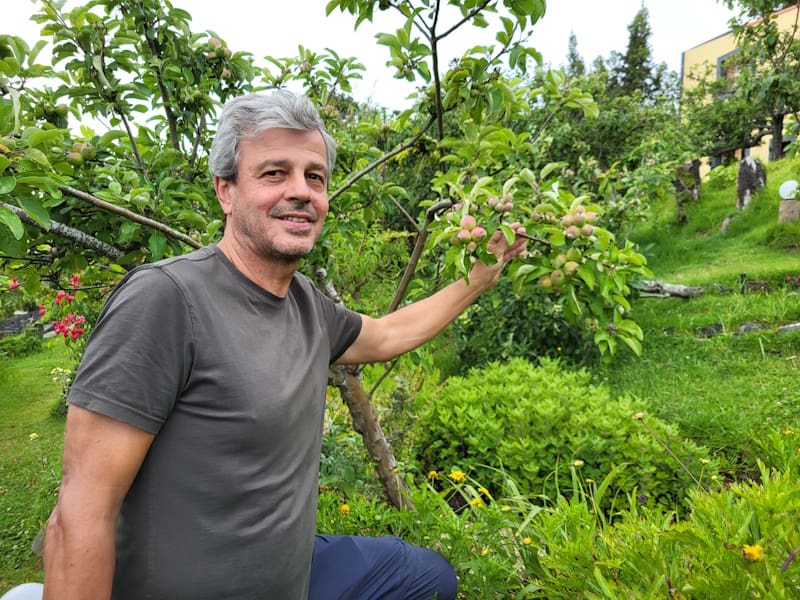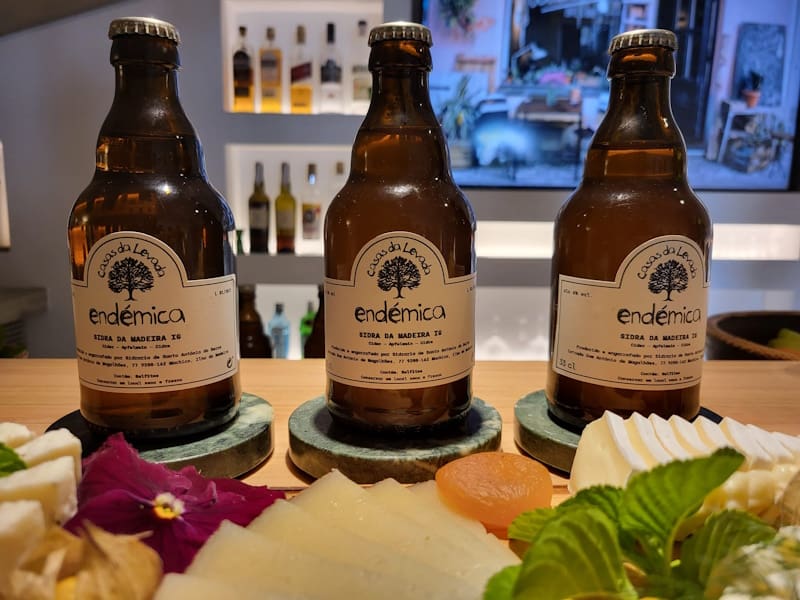Renewed Tradition

Cider production on the island of Madeira is as old as wine but is less prominent as it is considered to be of less economic interest. Times change, desires change. The cider tradition has been reborn with great strength, to the point that there is now a worldwide competition dedicated exclusively to this drink.
It all started a few years ago when Father Rui Sousa, founder of a community project in the parish of Prazeres (in the Municipality of Calheta) decided, among other activities, to support the inhabitants of his parish through the production of cider, using apples (pears, such as they call it) which were left over in large quantities. There are apple trees (pear trees) all over the island, but most of the time the fruit is not even picked, the trees serving to protect other crops from harsh winds. As there was a huge waste of fruit, the priest not only made use of it, but also began planting almost extinct varieties. Currently, the University of Madeira is already classifying and studying local varieties, and of the more than 130 species already identified, 10 are already part of the National Catalog of Varieties of Fruit Species: (Maçã Barral, Maçã Cara de Dama, Pêro Calhau, Pêro Domingos, Pêro Ponta do Pargo, Pêro Bico de Melro, Pêro Branco, Pêro da Festa, Pêro Focinho de Rato and Pêro Vime). Registration in this Catalog, recognized by the European Union, ensures the protection and preservation of a very rich regional plant genetic heritage and, in parallel, the creation of conditions to increase its production, as well as the development of commercial circuits for traditional Madeiran varieties.

Limited editions, quality ciders
Located in Ponta do Pargo, on the western tip of the island of Madeira, the ‘Casas da Levada’ project is dedicated to agritourism but also to cider production. Visited by the panel of judges after the competition, the charming property is located on the edge of the Laurissilva Forest, made up predominantly of trees and bushes indigenous to Madeira, a vegetation that already existed when the Portuguese navigators arrived and is considered a relic of the Tertiary period. . The producer, Joaquim Abreu, has just one hectare next to this paradise, but there are Pêro da Ponta do Pargo trees, one of the most used varieties in the production of cider, very aromatic and maturing faster.
When Joaquim acquired the land more than 20 years ago for family use and agritourism, he never imagined that one day he would dedicate himself to cider production: «Before, pears were used to eat and make sweets for guests’ breakfast. It was only more recently that we learned about the Sidra project and spoke to engineer Regina to guide us. Since then, we launched cider, which has been highly appreciated», explains Joaquim who, with the support of his wife, Maria Helena, and their children, André and Joaquim Abreu – an architect and another manager – have committed themselves to the development of agritourism but they are also cider enthusiasts today. «the pêro from Ponta do Pargo doesn’t exist on the mainland, it comes from here, from this part of the island, and that’s why we gave the cider the name ‘Endémica’. But as it is a very good variety, it already exists all over the island. Last year, 360 kilos of pears were harvested and around 250 liters were made, which was enough to bottle more than 700 33 cl bottles. These are small quantities and we want to do everything with high quality. And, although we do not have organic certification, it is produced organically», explains Joaquim, proud of his trees. The cider, «with a slightly fruity and citrus aroma, and with a taste of dried fruit and good acidity, is clean, tasty and very gastronomic», adds Regina Pereira, who further explains that the objective «is to continue working towards that the quality of cider is increasingly recognized».

Remember that cider dates back to the Romans and it was in England that its production developed the most, and it is still one of the three largest producers worldwide. It was, in fact, the English who introduced many of the existing varieties on the island of Madeira, and who taught the art of transforming pears into cider, as well as the habit of consumption.
The chronicles of Gomes Eanes de Zurara (1410-1474) already showed the existence of pear trees on the island, reports that made known the supply lists of the Portuguese fleets that, from the beginning of the 16th century, stopped to resupply at the various ports on the Island and took with them the precious ‘wine’, a term used at the time to designate cider. Since then, production has developed in parallel with the production of Madeira wine, which was economically more profitable. The ‘pear wine’, tasty but more modest, was then left to agricultural workers, often being made in the same facilities where Madeira wine was produced.
You can also add pears to the pear juice, which are available in some abundance. In any case, extracting pear juice compared to grape juice is much more difficult. The fruit has to be broken, for days on end, with vertical strikes made with hard wooden beams, or mallets. And only the great taste that Madeirans have for cider has made production endure, year after year.

Madeira, a privileged setting for cider production
Located in the subtropical region of the North Atlantic, the island of Madeira has a mild climate and low temperature range. As pome fruits (the family of trees to which apples, pears and quince belong) need greater temperature differences and some cold, the trees are distributed across the island at altitudes between 300 and 1000 meters. The soil, mostly volcanic, is rich in organic matter and highly acidic. The island’s diverse microclimates are also responsible for the different ripeness of the fruit, giving the cider a good balance between sweetness and acidity, as with Madeira wine, and oxidative hints that give it a unique character.
Its degree varies between 5 and 7% alcohol volume, and its color ranges from citrine yellow to straw yellow. In terms of aroma, it reveals notes of citrus or green apple to more mature notes, reminiscent of quince. With low residual sugar, derived from almost complete fermentations, its taste has good acidity, with some tannin in the mix, depending on the variety of pears used. Fermentation at low temperatures helps maintain aromas and flavors, which vary depending on aging in bottles or barrels. Due to its specificities, Madeira Cider was finally qualified as a GI (Geographical Indication) by the European Community, and its evolution to other levels is expected soon. It is the first national GI Cider, with very unique characteristics.

Whether natural, sweet, flavored, carbonated, sparkling, low alcohol or non-alcoholic, Madeiran cider is one of the most vibrant (re)discoveries in recent years.